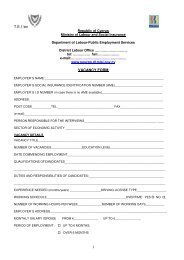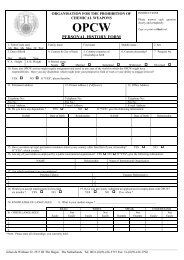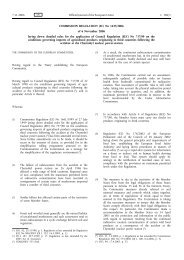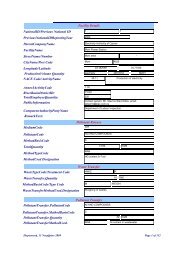Non binding guide to good practice for implementing Directive
Non binding guide to good practice for implementing Directive
Non binding guide to good practice for implementing Directive
- No tags were found...
You also want an ePaper? Increase the reach of your titles
YUMPU automatically turns print PDFs into web optimized ePapers that Google loves.
E.2 DAILY EXPOSURE: A(8), WHERE THERE IS MORE THAN ONE TASKIf a person is exposed <strong>to</strong> more than one source ofvibration (perhaps because they use two or more differentmachines or activities during the day) then a partialvibration exposure is calculated from the magnitude andduration <strong>for</strong> each axis and <strong>for</strong> each exposure. The partialvibration values are combined <strong>to</strong> give the overall dailyexposure value, A(8), <strong>for</strong> that person, <strong>for</strong> each axis. Thedaily vibration exposure is then the highest of the threesingle axis values.Step 1:Step 2:Determine the three frequency weighted r.m.sacceleration values a wx, a wyand a wz, <strong>for</strong> eachtask or vehicle, from manufacturer’s data,other sources, or measurement.For each vehicle or task, fi nd the partial dailyexposures in the three directions, x, y and zusing:Step 4:ExampleThe highest value of A x(8), A y(8) and A z(8) isthe daily vibration exposure.A delivery driver spends 1 hour loading his lorryusing a small <strong>for</strong>klift truck, followed by 6 hoursdriving the delivery lorry each day.Step 1: The vibration values on the seat are:Forklift truck✓ x-axis: 0.5 m/s²✓ y-axis: 0.3 m/s²✓ z-axis: 0.9 m/s²Step 2: The x, y and z axis daily exposuresare then:Forklift truckDelivery lorry✓ x-axis: 0.2 m/s²✓ y-axis: 0.3 m/s²✓ z-axis: 0.3 m/s²PART II Guide <strong>to</strong> <strong>good</strong> <strong>practice</strong> on Whole-Body Vibration – ANNEXES A-HWhereDelivery lorry✓✓T expis the daily duration of exposure<strong>to</strong> the vibration andT 0is the reference duration of eighthours.Each partial vibration exposure represents the contributionof a particular source of vibration (machine or activity)<strong>to</strong> the worker’s <strong>to</strong>tal daily exposure. Knowledge of thepartial exposure values will help you decide on yourpriorities: the machines or activities or processes with thehighest partial vibration exposure values are those thatshould be given priority <strong>for</strong> control measures.Step 3: Daily vibration exposure, <strong>for</strong> eachaxis are:Step 3: For each axis (j), the overall daily vibrationexposure can be calculated from the partialvibration exposure values, using:A j8) = A j1 (8)2 + A j2(8) 2 + A j3(8) 2 + …where A j1(8), A j2(8), A j3(8), etc. are the partial vibrationexposure values <strong>for</strong> the different vibration sources.Step 4: The driver’s daily whole-body vibrationexposure is the highest axis A(8)value, in this case the value <strong>for</strong> they or z-axes: 0.4 m/s², i.e. just belowthe exposure action value.93










![Hadjimichael[1].pdf](https://img.yumpu.com/33937965/1/190x135/hadjimichael1pdf.jpg?quality=85)





